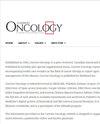影响肛门癌治疗效果和生存率的因素
IF 2.8
4区 医学
Q2 ONCOLOGY
引用次数: 0
摘要
背景:本研究旨在确定目前肛门癌治疗中的预后因素。研究方法我们回顾了 7 年内(2016-2023 年)肛门癌病例的管理和预后情况。主要目的是评估本院所有肛门癌患者的人口统计学特征、临床表现和预后。卡普兰-梅耶尔生存分析用于估算不同组群之间的生存差异,统计显著性通过对数秩检验确定。Cox比例危险回归用于确定预后因素。报告了Cox回归危险比、置信区间和P值。结果研究的中位随访时间为 29.8 个月。75名肛门癌患者被纳入本研究,其中88%(66/75)为鳞状细胞癌(SCC),大多数为区域性疾病(82.7%(62/75))。确诊时的中位年龄为 63.4 岁(36-94 岁)。女性占多数(57.3%(43/75))。总计84%(63/75)的患者接受了确定性化疗(dCRT),其中7/63(11.1%)的患者因残留或复发疾病需要进行挽救性腹部会阴切除术(APR)。不良预后指标包括:T4 疾病危险比 = 3.81,(95% CI 1.13-12.83,* p = 0.04),分化不良肿瘤疾病危险比 = 3.37,(95% CI 1.13-10.02,* p = 0.04),N2 结节状态 HR = 5.03,(95% CI 1.11-22.8,* p = 0.04),诊断时有转移性疾病 HR = 5.8,(95% CI 1.28-26.42,* p = 0.02)。结论包括分期、结节和分化状态在内的发病特征仍是肛门恶性肿瘤患者预后的关键指标。本文章由计算机程序翻译,如有差异,请以英文原文为准。
Factors Influencing Outcomes and Survival in Anal Cancer
Background: We aim to ascertain prognostic factors in the current management of anal cancer within this study. Methods: We reviewed the management and outcomes of anal cancer cases over a seven-year period, inclusive (2016–2023). The primary objectives were to assess the demographic characteristics, clinical presentation, and outcomes of all anal cancer patients within our institution. Kaplan–Meier survival analysis was used to estimate survival differences between cohorts, with statistical significance determined using log-rank testing. Cox proportional hazards regression was utilised to identify prognostic factors. Cox regression hazard ratios were reported along with confidence intervals and p-values. Results: The median follow-up time for the study was 29.8 months. Seventy-five patients with anal cancer were included in this study, with 88% (66/75) being squamous cell carcinoma (SCC) and the majority having regional disease (82.7% (62/75)). The median age at diagnosis was 63.4 years (36–94). There was a female preponderance (57.3% (43/75)). In total, 84% (63/75) underwent definitive chemoradiation (dCRT), with 7/63 (11.1%) requiring a salvage abdomino-perineal resection (APR) for residual or recurrent disease. Adverse prognostic indicators include those with T4 disease hazard ratio = 3.81, (95% CI 1.13–12.83, * p = 0.04), poorly differentiated tumour disease HR = 3.37, (95% CI 1.13–10.02, * p = 0.04), having N2 nodal status HR = 5.03, (95% CI 1.11–22.8, * p = 0.04), and having metastatic disease at diagnosis HR = 5.8, (95% CI 1.28–26.42, * p = 0.02). Conclusion: Presenting characteristics including stage, nodal, and differentiation status remain key prognostic indicators in those diagnosed with anal malignancy.
求助全文
通过发布文献求助,成功后即可免费获取论文全文。
去求助
来源期刊

Current oncology
ONCOLOGY-
CiteScore
3.30
自引率
7.70%
发文量
664
审稿时长
1 months
期刊介绍:
Current Oncology is a peer-reviewed, Canadian-based and internationally respected journal. Current Oncology represents a multidisciplinary medium encompassing health care workers in the field of cancer therapy in Canada to report upon and to review progress in the management of this disease.
We encourage submissions from all fields of cancer medicine, including radiation oncology, surgical oncology, medical oncology, pediatric oncology, pathology, and cancer rehabilitation and survivorship. Articles published in the journal typically contain information that is relevant directly to clinical oncology practice, and have clear potential for application to the current or future practice of cancer medicine.
 求助内容:
求助内容: 应助结果提醒方式:
应助结果提醒方式:


